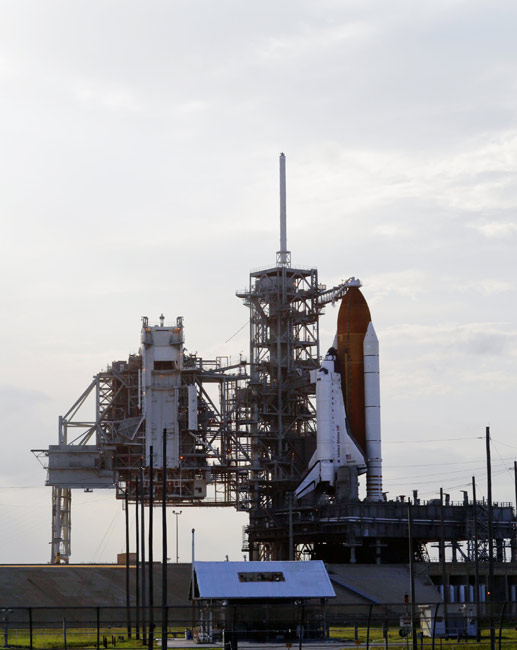Stormy Weather Delays Space Shuttle Launch Again

This story was updated at 8:50 p.m. EDT.
CAPE CANAVERAL, Fla. - Stormy weather again foiled NASA's plans to launch the space shuttle Endeavour late Monday, the fifth setback for the delay-plagued mission.
A cluster of lightning-spawning thunderstorms swooped in ahead of the shuttle's 6:51 p.m. EDT (2251 GMT) planned liftoff time, forcing mission managers to call off the attempted launch from NASA's seaside Kennedy Space Center.
"Certainly lightning rules are something that we don't want to cross when it comes to launching the space shuttle," said launch director Pete Nickolenko.
NASA will try again on Wednesday at 6:03 p.m. EDT (2203 GMT), when the weather outlook will improve to a 60 percent likelihood of favorable conditions.
"The weather looks fairly decent for Wednesday," said launch weather forecaster Scott McCormick of the 45th weather squadron.
Mission managers decided to stand down tomorrow to allow ground crews time to replace a loose plastic cap on one of the vehicle's 44 small rocket thrusters.
Get the Space.com Newsletter
Breaking space news, the latest updates on rocket launches, skywatching events and more!
The cover detached yesterday during Endeavour's fourth launch attempt, which was also canceled because of bad weather. Though the cap doesn't pose a threat to launch, if rain water gets into the nozzle it could freeze into ice and render the thruster useless.
Today's disappointment was the fifth for Endeavour's construction flight to the International Space Station, which has been delayed repeatedly by inclement weather and a gas leak that has since been fixed.
"Again, the vehicle and our teams were ready, but the weather has just bitten us again," Nickolenko told Endeavour's crew. "We're going to have to declare a scrub again today — sorry about that."
Shuttle commander Mark Polansky said he understood. "That's the nature of our business," he said. "Like I said before, when the time is right, we'll be here and we'll be ready."
So far, NASA hoped to launch Endeavour on time in order to avoid a space traffic conflict between its marathon 16-day mission and an unmanned Russian cargo ship that is also due at the space station later this month. To make way for the Progress spacecraft to dock, NASA is planning ways to shift around activities during Endeavour's flight to allow the shuttle to undock earlier than planned. If Endeavour launches on Wednesday, the mission shouldn't have to give up any goals, but simply rearrange its schedule, Endeavour's mission management chair Mike Moses said today.
"The teams are working through that right now," Moses said. "They think they have a real solid plan. We have Wednesday now in the bag as a launch attempt."
If the shuttle cannot get off the ground Wednesday, NASA may try for Thursday, though that would likely require cutting at least one spacewalk from the STS-127 mission. After that, the shuttle must stand down until July 26.
Endeavour is slated for a grueling mission packed with five spacewalks and complicated robotic maneuvers to finish construction on the space station's Japanese-built Kibo lab. Polansky will lead a crew of seven astronauts to deliver and install an outdoor research platform for Kibo, as well as a host of new supplies. Endeavour's flight will also drop off NASA astronaut Tim Kopra to begin a long -duration stint at the space station as an Expedition 20 flight engineer.
SPACE.com is providing continuous coverage of STS-127 with reporter Clara Moskowitz at Cape Canaveral and senior editor Tariq Malik in New York. Click here for mission updates and SPACE.com's live NASA TV video feed.
Join our Space Forums to keep talking space on the latest missions, night sky and more! And if you have a news tip, correction or comment, let us know at: community@space.com.

Clara Moskowitz is a science and space writer who joined the Space.com team in 2008 and served as Assistant Managing Editor from 2011 to 2013. Clara has a bachelor's degree in astronomy and physics from Wesleyan University, and a graduate certificate in science writing from the University of California, Santa Cruz. She covers everything from astronomy to human spaceflight and once aced a NASTAR suborbital spaceflight training program for space missions. Clara is currently Associate Editor of Scientific American. To see her latest project is, follow Clara on Twitter.









